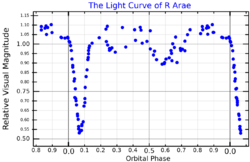Astronomy:R Arae
| Observation data Equinox J2000.0]] (ICRS) | |
|---|---|
| Constellation | Ara |
| Right ascension | 16h 39m 44.726s[2] |
| Declination | −56° 59′ 39.92″[2] |
| Apparent magnitude (V) | 6.17 (- 6.20) - 7.32[3] |
| Characteristics | |
| Spectral type | B9Vp[4] (B5V + F1IV[5]) |
| B−V color index | 0.10[5] |
| Variable type | Algol[4] |
| Astrometry | |
| Radial velocity (Rv) | +5.5[5] km/s |
| Proper motion (μ) | RA: −4.991[6] mas/yr Dec.: −17.810[6] mas/yr |
| Parallax (π) | 3.3603 ± 0.0647[6] mas |
| Distance | 970 ± 20 ly (298 ± 6 pc) |
| Absolute magnitude (MV) | −0.48 + 0.00[5] |
| Orbit[5] | |
| Period (P) | 4.425 d |
| Eccentricity (e) | 0 |
| Inclination (i) | 78.0° |
| Semi-amplitude (K1) (primary) | 55.3 km/s |
| Semi-amplitude (K2) (secondary) | 181.6 km/s |
| Details[5] | |
| A | |
| Mass | 5.0 M☉ |
| Radius | 3.41 R☉ |
| Luminosity | 257 L☉ |
| Surface gravity (log g) | 4.07 cgs |
| Temperature | 12,500 K |
| Rotational velocity (v sin i) | 202[5] km/s |
| B | |
| Mass | 1.5 M☉ |
| Radius | 5.97 R☉ |
| Luminosity | 78 L☉ |
| Surface gravity (log g) | 3.07 cgs |
| Temperature | 7,000 K |
| Rotational velocity (v sin i) | 73 km/s |
| Other designations | |
| Database references | |
| SIMBAD | data |
R Arae is an Algol-type eclipsing binary in the constellation Ara. Located approximately 298 parsecs (970 ly) distant, it normally shines at magnitude 6.17, but during eclipses can fall as low as magnitude 7.32.[3] It has been suggested by multiple studies that mass transfer is occurring between the two stars of this system,[7][8] and the period of eclipses seems to be increasing over time.[8] The primary is a blue-white main sequence star of spectral type B5V that is 5 times as massive as the Sun, while the secondary is a yellow-white star of spectral type F1IV that is 1.5 times as massive as the Sun. Stellar material is being stripped off the secondary and accreting on the primary.[5]
R Arae has an 8th-magnitude companion 3″ away.[5] The companion star is at a similar distance.[9]
References
- ↑ Blane, D.; Blackford, M. G.; Budding, E.; Reed, P. A. (May 2019). "New light on R Arae". Information Bulletin on Variable Stars 6267 (1). doi:10.22444/IBVS.6267. https://konkoly.hu/pub/ibvs/6201/6267.pdf. Retrieved 24 October 2021.
- ↑ 2.0 2.1 Van Leeuwen, F. (2007). "Validation of the new Hipparcos reduction". Astronomy and Astrophysics 474 (2): 653–664. doi:10.1051/0004-6361:20078357. Bibcode: 2007A&A...474..653V.
- ↑ 3.0 3.1 VSX (25 October 2010). "R Arae". AAVSO Website. American Association of Variable Star Observers. http://www.aavso.org/vsx/index.php?view=detail.top&oid=2804. Retrieved 30 June 2014.
- ↑ 4.0 4.1 Samus, N. N. et al. (2009). "VizieR Online Data Catalog: General Catalogue of Variable Stars (Samus+ 2007-2013)". VizieR On-line Data Catalog: B/GCVS. Originally Published in: 2009yCat....102025S 1: B/gcvs. Bibcode: 2009yCat....102025S.
- ↑ 5.0 5.1 5.2 5.3 5.4 5.5 5.6 5.7 5.8 Bakıș, H.; Bakıș, V.; Eker, Z.; Demircan, O. (2016). "Active binary R Arae revisited: Bringing the secondary component to light and physical modelling of the circumstellar material". Monthly Notices of the Royal Astronomical Society 458 (1): 508–516. doi:10.1093/mnras/stw320. Bibcode: 2016MNRAS.458..508B.
- ↑ 6.0 6.1 6.2 Brown, A. G. A. (August 2018). "Gaia Data Release 2: Summary of the contents and survey properties". Astronomy & Astrophysics 616: A1. doi:10.1051/0004-6361/201833051. Bibcode: 2018A&A...616A...1G. Gaia DR2 record for this source at VizieR.
- ↑ Nield, K. M. (1991). "Observations and analysis of the Southern binary R Arae". Astrophysics and Space Science 180 (2): 233–252. doi:10.1007/BF00648180. Bibcode: 1991Ap&SS.180..233N.
- ↑ 8.0 8.1 Reed, P. A.; McCluskey Jr., G. E.; Kondo, Y.; Sahade, J.; Guinan, E. F.; GiméNez, A.; Caton, D. B.; Reichart, D. E. et al. (2010). "Ultraviolet study of the active interacting binary star R Arae using archivalIUEdata". Monthly Notices of the Royal Astronomical Society 401 (2): 913. doi:10.1111/j.1365-2966.2009.15741.x. Bibcode: 2010MNRAS.401..913R.
- ↑ Brown, A. G. A. (August 2018). "Gaia Data Release 2: Summary of the contents and survey properties". Astronomy & Astrophysics 616: A1. doi:10.1051/0004-6361/201833051. Bibcode: 2018A&A...616A...1G. Gaia DR2 record for this source at VizieR.
 |


